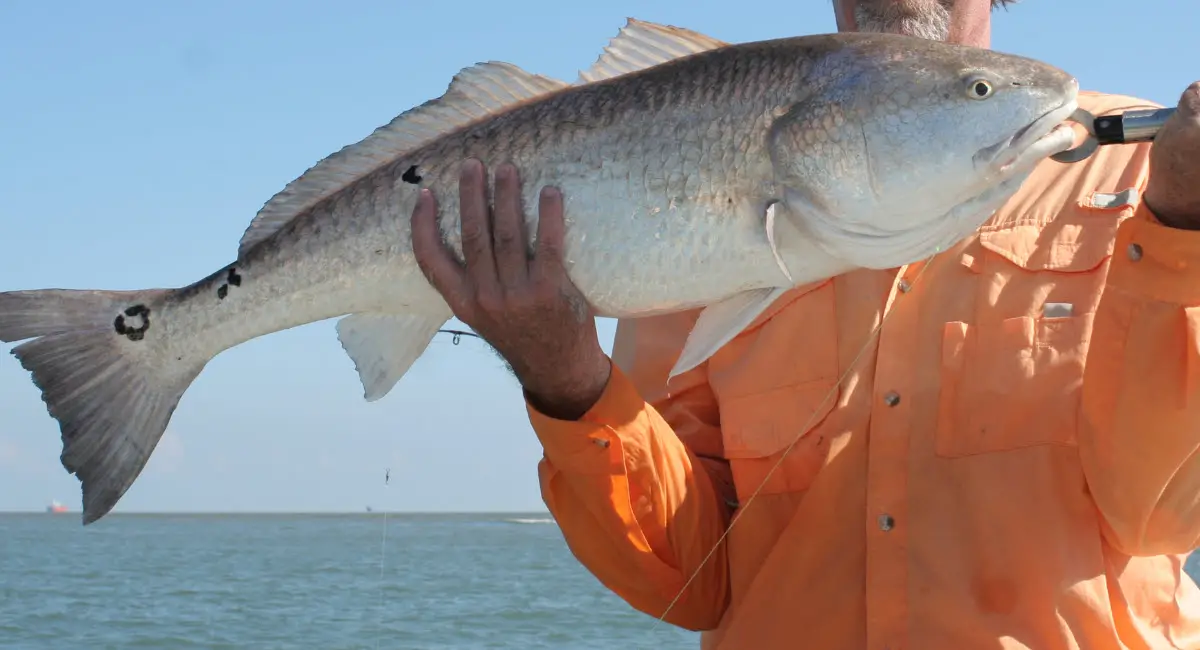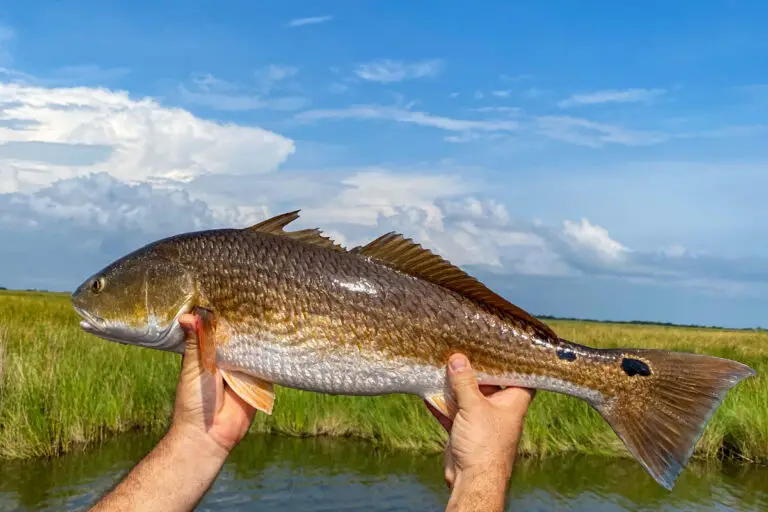Texas Redfish Limit: How to Stay Compliant and Enjoy Your Catch
Estimated reading time: 11 minutes
As an angler, there is no doubt that catching a vibrant redfish in Texas waters is a thrilling experience. However, staying within the Texas Redfish Size Limit is crucial while enjoying your catch.
The regulations for catching redfish in Texas include a bag limit, a possession limit, and red drum tag are:
- Bag Limit: Anglers can catch up to three redfish per day, with a minimum size of 20 inches and a maximum size limit of 28 inches.
- Possession Limit: Anglers can possess up to six redfish at a time, which includes their daily catch and any fish they have stored at home.
- Red Drum Tag: The red drum tag allows anglers to keep one red drum per day that is greater than 28 inches in length. This tag is obtained with a valid fishing license and must be attached to the fish immediately after catching it.
- Bonus Red Drum Tag: An angler with a bonus red drum tag can keep one additional red drum per day that is greater than 28 inches in length.
This article covers the Texas Redfish Limits regulations, including size and bag limits, the slot limit, and the red drum tag. We will also discuss penalties for violating the limit and provide tips for measuring redfish accurately, keeping track of your daily bag limit, and properly tagging and reporting harvested red drum.
Additionally, we’ll provide an overview of different types of redfish and their characteristics, as well as tips and techniques for maximizing your catch within the limit.
Why It’s Important to Follow the Redfish Limits in Texas
Fishing regulations exist to protect fish populations and ensure their sustainability. It’s important to understand the rules and regulations regarding the harvest of different species, including redfish, and comply with these regulations.
Failure to follow the rules can result in fines or penalties. Coastal fisheries and game wardens work to enforce these regulations and preserve fish populations for future generations. Review Texas fishing regulations before your next fishing trip to ensure compliance.
Texas Fishing Regulations
The most important requirement is having a valid fishing license. This applies to all types of fishing, whether recreational or commercial. Fishing licenses in Texas are valid for one year from the date of purchase and can be obtained online or in person from the Texas Parks and Wildlife Department.
Texas has both state and federal waters, and the regulations for fishing in these areas can differ. State waters typically extend to nine nautical miles from the shoreline, while federal jurisdiction begins beyond the nine nautical mile limit and into the Gulf of Mexico. Anglers must comply with federal and state regulations when fishing in federal waters.
Overview of the Redfish Limit Regulations in Texas
Explanation of the Size and Bag Limits
In Texas, anglers can catch up to three redfish per day as long as the fish measure between 20 and 28 inches long. This is called the bag limit.
Anglers can keep up to six redfish at a time, which includes the fish they caught that day and any fish they have stored at home. This is called the possession limit.
Anglers can keep one red drum per day that is greater than 28 inches in length with a red drum tag. This tag is available with a valid fishing license and must be attached to the fish as soon as it is caught.
Anglers with a bonus red drum tag can keep one extra fish per day that is greater than 28 inches long.
Other species like speckled trout, red snapper, black drum, and flounder also have specific size and bag limits to ensure sustainable populations.
Overview of the Red Drum Tag and Its Role in Enforcing the Limit
The red drum tag is a key element of Texas saltwater fishing regulations. It helps to control the bag limit for red drum fishing, which is one red drum per person per day with a maximum length of 28 inches. An angler with a bonus tag can keep one additional fish between 28 and 50 inches long.
To possess a red drum tag, anglers must have a valid Texas fishing license for the current year. The tag must be immediately attached to the fish after it is caught and completed with the angler’s name, date, and location of the catch.
The red drum tag system is essential to monitor the number of fish caught along the Texas coast and maintain a healthy and sustainable red drum population for future generations.
How to Properly Tagging and Report Harvested Red Drum
When harvesting a red drum, anglers must immediately tag the fish with their name, date, and location of the catch. It is essential to complete the tag accurately and attach it securely to the fish.
After tagging, anglers must report their harvest within 24 hours by calling the number listed on their tag. Reporting the harvest helps fishery managers track the number of fish caught and ensures that anglers stay within the legal limit.
Penalties and Consequences of Violating the Limit
The Texas Parks and Wildlife Department (TPWD) game wardens enforce fishing regulations and issue citations to violators who do not follow redfish limits.
Violating the redfish limit can result in fines ranging from $100 to $500 or more, depending on the violation’s severity. Repeated violations can result in license suspension or revocation, impacting an angler’s ability to fish in Texas waters.
How To Stay Compliant with The Texas Redfish Limit
Tips for Measuring Redfish Accurately to Stay Within the Redfish Size Limit
Always carry a measuring device while fishing, such as a ruler, tape measure, or fish measuring board, to measure redfish accurately and stay within the size limit. This helps you quickly measure the fish and return it to the water without harming it unnecessarily.
When measuring a redfish, start at the tip of its nose and measure to the end of its tail while keeping its mouth closed and tail pinched. Remember, redfish should be measured from the tip of their nose, not the head’s or gills’ center.
By following these tips, anglers can ensure they are measuring their redfish correctly and staying within Texas fishing regulations’ size limits.
Strategies For Keeping Track of Your Daily Bag Limit
Keeping track of your daily bag limit is crucial for staying compliant with Texas fishing regulations. Here are some strategies to help you keep track:
- Count your catch: One simple strategy to keep track of your daily bag limit is to count your catch as you reel them in. This can help you avoid accidentally exceeding the bag limit.
- Use a tally system: Use a tally system to keep track of the number of fish you catch. You can use a pen and paper or even a phone app to keep track of your tally throughout the day.
- Remove caught fish from the water: If you’re catching fish from a pier or shoreline, remove caught fish to avoid confusion about what you have caught and what you still need to catch to meet your daily limit.
- Label your cooler: Label your cooler with the number of fish you have caught and the species to keep track of your catch.
Keeping track of your daily bag limit can be challenging, but these strategies can help you stay compliant with Texas fishing regulations. Counting your catch, using a tally system, removing caught fish from the water, and labeling your cooler are all effective ways to keep track of your daily bag limit. By taking these simple steps, you can enjoy your fishing trip while ensuring that you stay within the legal limits of Texas fishing regulations.
Different Types of Redfish
“Bull Reds”, “Slot Reds”, and “Puppy Reds” are names used to describe different groups of redfish based on their size or age. These names are not official or scientific but are used by people who enjoy fishing. They are nicknames for different types of redfish that are commonly caught.
- Bull Reds: This term is often used to refer to large redfish, usually those over 27 inches long or weighing more than 10 pounds. Bull reds are typically older fish known for their size and strength. They are popular among anglers for their challenging fight, making for a great catch-and-release fishing experience.
- Slot Reds: This term refers to redfish that fall within a certain size range or slot limit, as determined by state regulations. In Texas, the slot limit for redfish is between 20 and 28 inches long, with a daily bag limit of three fish per angler per day. Slot reds are often the most commonly caught redfish due to their abundance and legal status.
- Puppy Reds: This term is used to describe juvenile or young redfish, typically less than 14 inches in length. They are called puppy reds because they resemble a young puppy and are often the smallest redfish caught by anglers. Puppy reds are typically released back into the water to grow and mature into larger fish.
Redfish Nicknames
- Old Drum: This term is often used to refer to large, mature redfish over 30 inches long and weighing over 15 pounds. Old drums are typically targeted by experienced anglers due to their size and challenging fight. They are also popular catch-and-release fish.
- Channel Bass: This is an older term used to describe redfish, dating back to the 19th century. The name comes from the redfish’s tendency to congregate in channels and passes between islands or along the coastline. The term is less commonly used today but may still be heard in some regions.
- Rat Reds: This term is sometimes used to describe very small redfish, usually less than 12 inches long. They are called “rat” reds because of their small size and are typically too small to keep for consumption. Rat reds are often caught by beginners or children and can be a fun and easy fish to target.
- Blue Tail and Blue Runner: Redfish are known as Blue Tail or Blue Runner due to their distinguishable blue tail that fades to a coppery bronze color towards the head.
Maximizing Your Catch Within Redfish Limit
Tips For Catching Redfish Within the Limit
- Understanding Redfish Habits and Habitat: Fish at popular locations known for having larger redfish populations, such as Packery Channel and Lower Laguna Madre. Look for structures such as oyster bars, mangroves, and grass beds where redfish feed and hide.
- Use the Right Bait: The right bait is crucial in catching redfish. Live bait, such as shrimp, mullet, and crabs, are the go-to choices for many anglers. Artificial lures such as soft plastic baits and topwater plugs are also effective in catching redfish.
- Fishing at the Right Time: Redfish are most active during specific times of the day. Early mornings and late afternoons are the best times to catch redfish, as they are more active during cooler temperatures.
Recommended Fishing Gear and Techniques
Gear for Redfish Fishing:
- Rod and Reel: A medium-heavy rod and reel combo is ideal for redfish fishing. A 7-foot rod with a fast action tip and a reel with a strong drag system will help you fight against these powerful fish.
- Fishing Line: A 20 to 30-pound braided line is recommended for redfish fishing. This type of line offers the sensitivity to feel the bite and the strength to fight against the fish.
- Circle hook: A circle hook is popular for redfish fishing because it is less likely to hook the fish in the gut or gills, reducing harm to the fish. The hook’s curved shape allows it to slide out of the fish’s throat and hook in the corner of the mouth.
Techniques for Redfish Fishing:
- Sight Fishing: Sight fishing is a popular technique for catching redfish. Look for tailing or waking redfish in shallow waters and cast your bait toward them.
- Drift Fishing: Drift fishing involves drifting your bait or lures with the current. This technique can be effective in catching redfish that are feeding in deeper waters.
- Bottom Fishing: Bottom fishing is a popular technique for catching redfish. Anchor your boat and drop your bait to the bottom. Redfish like to feed on the bottom, so this technique can be effective in catching them.
Frequently Asked Questions
The daily bag limit for redfish in Texas is three fish per person per day, with a minimum size of 20 inches and a maximum size of 28 inches.
The possession limit for redfish in Texas is six fish per angler, which includes their daily catch and any fish they have stored at home.
The red drum tag permits an angler to keep one red drum per day that is greater than 28 inches in length. This tag is obtained with a valid fishing license and must be attached to the fish immediately after catching it.
The bonus red drum tag allows an angler to keep one additional red drum per day that is greater than 28 inches in length.
The penalty for violating the redfish limit in Texas can range from fines ranging from $100 to $500 or more, depending on the violation’s severity, to imprisonment, and repeated violations can result in license suspension or revocation.
Other Sources
Conclusion
Catching redfish in Texas can be an exciting and fulfilling experience for anglers, but it is important to abide by the state’s regulations to ensure the sustainability of the redfish population.
These regulations include size and bag limits, possession limits, and the red drum tag system, which helps to monitor the number of fish caught and maintain healthy populations. Violating these regulations can result in fines, imprisonment, and license suspension or revocation.
To stay compliant, anglers should carry a measuring device to measure redfish accurately, keep track of their daily bag limit, and properly tag and report harvested red drum.
By following these tips and techniques, anglers can enjoy a successful fishing trip while preserving the redfish population for future generations.







